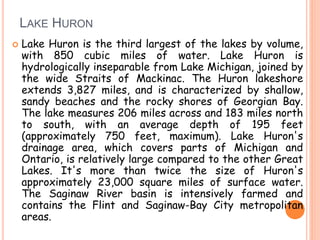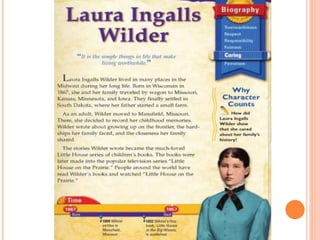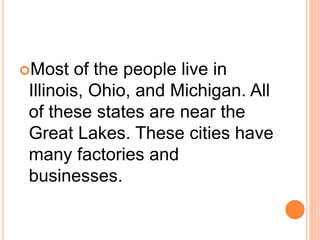6th social studies
- 1. Social Studies NORTH CENTRAL REGION 3rd TERM Boston International School
- 2. GEOGRAPHY OF THE NORTH CENTRAL REGION Objective: To recognize the general and specific characteristics of a region as an instrument to value the cultures as brothers created by God. Learning Objectives: Identifies the main characteristics of the geography and people of the region to develop a wider sense of respect toward the culture.
- 3. Biblical principle: Philippians 3:20 New King James Version (NKJV) For our citizenship is in heaven, from which we also eagerly wait for the Savior, the Lord Jesus Christ.
- 5. GEOGRAPHY OF THE NORTH CENTRAL REGION
- 6. States and Capitals: STATE NAME STATE CAPITAL North Dakota Bismarck South Dakota Pierre Iowa Des Moines Indiana Indianapolis Missouri Jefferson City Michigan Lansing Nebraska Lincoln Wisconsin Madison Illinois Springfield Minnesota St. Paul Kansas Topeka Ohio Columbus
- 7. Like the Southeast Region, the North Central Region has 12 states. But the North Central Region is much flatter than the Southeast. There are a few mountains and hills.
- 8. LAKE MICHIGAN Lake Michigan is the third largest Great Lake by surface area and the sixth largest freshwater lake in the world. Because Lake Michigan is joined to Lake Huron at the Straits of Mackinac, they are considered one lake hydrologically. Many rivers and streams flow into Lake Michigan, and the major tributaries are the Fox-Wolf, the Grand and the Kalamazoo. There is a diversion from the lake into the Mississippi River basin through the Illinois Waterway at the Chicago River.
- 9. LAKE MICHIGAN LENGTH: 307 miles / 494 km. BREADTH: 118 miles / 190 km. AVERAGE DEPTH: 279 ft. / 85 m MAXIMUM DEPTH: 925 ft. / 282 m. VOLUME: 1,180 cubic miles / 4,920 cubic km. WATER SURFACE AREA: 22,300 sq. miles / 57,800 sq. km.
- 11. LAKE SUPERIOR Not only is Lake Superior the largest of the Great Lakes, it also has the largest surface area of any freshwater lake in the world. It contains almost 3,000 cubic miles of water, an amount that could fill all the other Great Lakes plus three additional Lake Eries. With an average depth approaching 500 feet, Superior also is the coldest and deepest (1,332 feet) of the Great Lakes. The lake stretches approximately 350 miles from west to east, and 160 miles north to south, with a shoreline almost 2,800 miles long. The drainage basin, totaling 49,300 square miles, encompasses parts of Michigan, Minnesota, Wisconsin and Ontario. Most of the Superior basin is sparsely populated, and heavily forested, with little agriculture because of a cool climate and poor soils.
- 13. LAKE HURON Lake Huron is the third largest of the lakes by volume, with 850 cubic miles of water. Lake Huron is hydrologically inseparable from Lake Michigan, joined by the wide Straits of Mackinac. The Huron lakeshore extends 3,827 miles, and is characterized by shallow, sandy beaches and the rocky shores of Georgian Bay. The lake measures 206 miles across and 183 miles north to south, with an average depth of 195 feet (approximately 750 feet, maximum). Lake Huron's drainage area, which covers parts of Michigan and Ontario, is relatively large compared to the other Great Lakes. It's more than twice the size of Huron's approximately 23,000 square miles of surface water. The Saginaw River basin is intensively farmed and contains the Flint and Saginaw-Bay City metropolitan areas.
- 15. LAKE ERIE Lake Erie is the smallest of the Great Lakes in volume (119 cubic miles) and is exposed to the greatest effects from urbanization and agriculture. Measuring 241 miles across and 57 miles from north to south, the lake's surface is just under 10,000 square miles, with 871 miles of shoreline. The average depth of Lake Erie is only about 62 feet (210 feet, maximum). It therefore warms rapidly in the spring and summer, and frequently freezes over in winter. The drainage basin covers parts of Indiana, Michigan, Ohio, Pennsylvania, New York and Ontario. Because of its fertile soils, the basin is intensively farmed and is the most densely populated of the five lake basins.
- 17. LAKE ONTARIO Lake Ontario is similar to Lake Erie in length and breadth (193 miles by 53 miles). Yet with its greater average depth (approximately 283 feet), Lake Ontario holds almost four times the volume (395 cubic miles) and has a retention time of about 6 years. The drainage basin covers parts of Ontario and New York, and a small portion of Pennsylvania. Major urban industrial centers, such as Hamilton and Toronto, are located on its shore. The U.S. shore is less urbanized and is not intensively farmed.
- 35. PEOPLE OF THE NORTH CENTRAL REGION Over 70 million people live in the 12 states of the North Central Region. But more of than half of these people live in just three state: Illinois, Ohio, and Michigan. The reason of this is because the other 9 states are where the farms are. Farms need lots of space.
- 37. Most of the people live in Illinois, Ohio, and Michigan. All of these states are near the Great Lakes. These cities have many factories and businesses.
- 38. Chicago, Illinois, is the largest city in the region. Almost 3 million people live there. Chicago is the major transportation center. It is a major port. O`Hare Airport in Chicago is one of the largest and busiest airports in the world. Chicago is also a major center for railroad transportation.
- 42. More than 80.000 people live in Duluth, Minnesota. Duluth is an important port city. Products like iron ore and grain are sent from Duluth to other places in huge ships.
- 44. ECONOMY OF THE NORTH CENTRAL REGION Service businesses are very important in the North Central Region. Other businesses are also important to the region. Near the Great Lakes, people manufacture a lot of things. On the plains, people have farms and ranches
- 45. Many American cars are made near the Great Lakes. Detroit, Michigan, is the center of the United States automobile business. In 1903, Henry Ford began making cars in Detroit. His “Model T” was the first automobile that many people could buy. The Model T was made on an assembly line. Each worker does one job over and over again on the cars on the assembly line.
- 47. ASSEMBLY LINE FORD http://www.youtube.com/watch?v=8rG1JZZ4UkQ
- 48. One of the reasons Henry Ford decided to build his factory in Detroit was bacause it is a port. Detroit is on a river between Lake Huron and Lake Erie. Ships carrying steel and other things used to build cars arrive in Detroit every day. Ships also travel across the Great Lakes carrying grains such as corn and wheat and other foods.
- 49. Corn is the biggest crop grown in the North Central Region. Cron farmers of the region grow more corn that any other farmers in the world. A lot of the grain grown in the region is fed to cattle and other animals. That is because there are many farms in the North Central Region that just raise animals.
- 53. DETROIT
- 54. KANSAS
- 55. ST LOUIS
- 56. RELIGION Like most of the United States, the Midwest is predominantly Christian. Roman Catholicism is the largest religion in the Midwest, varying between 18 percent and 34 percent of the state populations. Southern Baptists compose about 15 percent of Missouri's population and smaller percentages in other Midwestern states. Many Midwesterners are Protestant with rates from 48 percent in Illinois to 63 percent in Iowa. Lutherans are prevalent in the Upper Midwest, especially in Minnesota and the Dakotas with their large Scandinavian and German populations. Judaism is practiced by 2.5 percent and Islam is practiced by 1 percent or less of the population, with higher concentrations in major urban areas. People with no religious affiliation make up 13–16 percent of the Midwest's population. Surveys show 54 percent of Midwesterners regularly attend church























































